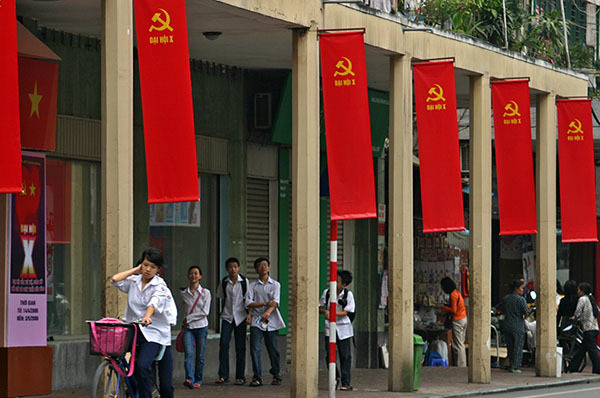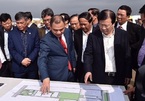 |
The question of the top leader of Vietnam is one of many that need to be addressed at the upcoming XIII Congress, for which the Central Executive Committee is preparing.
If the Party and the people's will unite, the problem can be solved no matter how difficult it is. In this regard, the will of the Party is taking shape. But what about the people? There are hundreds of ideas.
VietNamNet would like to introduce an article by Dr. Dinh Duc Sinh about this matter.
By 2045, the country's name will still be the Socialist Republic of Vietnam
In 1945, the August Revolution gave birth to the Democratic Republic of Vietnam. After 35 years, in 1980, the name of the country was changed to the Socialist Republic of Vietnam with the expectation of advancing rapidly, strongly and firmly to socialism.
From now until 2045, the transition to socialism will continue for another 26 years, bringing the country closer to socialism than at any other time in history. Therefore, the name of the country does not need to be changed, so it is still the Socialist Republic of Vietnam.
By 2045, the Communist Party of Vietnam (CPV) will be a fully institutionalized ruling party
In his testament, President Ho Chi Minh wrote "Our Party is a ruling Party." However, in implementation, the Constitutions 1980, 1992, 2013 did not specify it clearly. They all only recorded the leadership of the Party. It is similar for the Party's documents, with the content on the ruling Party occupying a very small proportion compared to the content on the Party’s leadership.
There is a misconception among people that the Party holding leadership means it is the ruling Party. As a result, the Vietnamese government system has two parallel systems: the Party system and the State system. Such specialized systems of administration are cumbersome and costly, and the leadership overlaps between the two systems.
In the draft documents on Party building that will be submitted to the upcoming Congress of the Communist Party of Vietnam, the issue of implementing President Ho Chi Minh’s testament on the ruling Party will certainly be more emphasized than in previous congresses. By the time the Party turns 100 in 2030, the issue of the ruling Party will be fully institutionalized.
When the Socialist Republic of Vietnam turns 100, the ruling Party institution will have been perfected.
By 2045, Vietnam’s economy will be in the world’s top 20-30
In 2018, Vietnam ranked 49th on the IMF's World Economic Rankings, based on GDP.
However, in 2013, the position of Vietnam was 41. Taking back this position within 5 years under the term of the XIII Congress is completely within reach, with a GDP growth rate of approximately 7% per year, and the VND/USD exchange rate is stable at around VND23,000/US$1.
The XIII Congress is a 20-year journey to 2045, or 4 terms of the Party Congress and 4 terms of the National Assembly and the Government. Each term will bring the country to a new phase of development in both quantity and quality, closer to the expectation of becoming a powerful nation.
At the age of 100, the Socialist Republic of Vietnam can stand among the top 20-30 economies of the world, which includes Australia, Netherlands, Thailand, Philippines, Malaysia and others.
To take off, Vietnam's market economy needs to work in accordance with the characteristics and rules of the transition period, without spending time searching for other unprecedented orientations.
By 2045, the institution of socialist ownership would have undergone three models, and will be approaching a complete model
In its constitutional history, Vietnam has experienced three models of socialist ownership. The 21-year period (1959-1980) was the time for a model that did not distinguish the ownership of the entire people from the state ownership; the period of 33 years later (1980-2013) was the time for the people’s ownership model, without the state ownership; and the time since 2013 has been the model of representatives for the entire people’s ownership.
All three models have a big disadvantage: They were unsuited to the characteristics of the transition period, when Vietnam has many economic sectors, many types of ownership, and many forms of production and business organizations.
Before the Socialist Republic of Vietnam turns 100, the above disadvantage will soon be solved under the following circumstances: 1/ When the State is still necessary and plays an important role for the country and when there is a state economy, then State ownership must be restored; 2/For properties which cannot be handed over to anyone or any organization, the whole-people ownership regime with the State being the representative of ownership must be maintained; 3/For properties defined by international law to be properties belonging to the sovereignty of the nation, the state assumes this right.
Because they are unsuited for the characteristics of the transition period, the three models above have created “gaps”, leading to the wasteful use of public assets and corruption, causing great discontent in society, especially on land issues.
The Land Law has set a record for the number of amendments and supplements compared to other laws, but it still does not meet the requirements of real life, so it needs to be further amended in the near future.
The National Assembly recently agreed to postpone the revision of the Land Law by 2020 but stressed that there should be not so long. However, this delay was caused by the need to amend and supplement institutions on land at the constitutional level, and even in the Party’s policies.
People are hoping that the XIII Party Congress will give priority to this issue. The problems in society associated with land all have the common factor: land use rights. This right is essentially a property right. Unlike leasing land, individuals and organizations that are assigned land use rights by the State are naturally the owners of the land they are given with land use rights.
Therefore, along with the establishment of the whole people’s ownership over land, a derivative factor has appeared, which is the market of land use rights.
This is a market of millions of individuals and organizations using land, including: 10 million agricultural production households, 5 million family-scale economic households, 715,000 private enterprises, nearly 900 state-owned enterprises, and more than 20 million households whose houses are built on land owned by all the people.
All are waiting for a land use right market that is organized and operates like other markets in the transitional period. There, the owner of the land use right is allowed to transfer that right according to market relations, not by administrative orders.
If so, then social problems associated with land will be cleared. Land acquisition and site clearance will no longer be a fear for real estate project developers. Land-related corruption and lawsuits will no longer exist.
The above-mentioned derivative market of land use rights has revealed inadequacies in the country's economic, political and social life. No matter how complicated and difficult is, these inadequacies cannot continue to exist to 2045. This will be a breakthrough that all the people have been waiting for.
By 2045, the alliance between the working class, the farmers and the intellectual class will see a new factor
One of the important features of the transition period is the emergence of new elements within and beside the old ones.
During the process of building and developing a new society, eliminating and renovating the old society since 1945 to the present, the political alliance between the working class, the peasant class and the intellectual class has contributed to the nation's historical achievements.
Over 30 years of Doi Moi (renovation), this alliance, from its practical activities, has brought about a new factor, which is a class in society, structured from the economic links between workers and farmers, peasants and intellectuals.
This class is called the middle class, besides the rich and the poor. The middle class is growing in both quantity and quality. By 2045 it will become the largest part of the great unity of the people.
This class comes from the results of decades of poverty reduction. It is estimated that at present, the poor class accounts for about 6% of the population, those who have just escaped from poverty account for 34%, the wealthy or very wealthy class is around 15%, and the middle class is about 45%.
By 2045, the middle class will increase strongly. According to the World Bank, each year 1.5 million Vietnamese join the middle class.
The emergence of the middle class makes the political alliance between the working class, the peasantry and the intellectual class spread to an economic union in various forms such as: bilateral links (industry- agriculture production); three-party linkages (businesspeople - state - scientists); 4-way linkages (production - technology - institutions - administrative reform) and others.
The development of the above alliance, both politically and economically, will create an important motivation for Vietnam to progress to success, especially in the implementation of the goal of building a strong country with financially secure people, putting an end to the transition period.
Dr. Dinh Duc Sinh

Who will lead Vietnam's economy?
Since it normalized relations with the powers like China in 1991 and the USA in 1995, Vietnam has begun to integrate into the global economy.

New growth incentives for Vietnamese economy
Vietnam’s GDP rose by 7.31% in the third quarter of this year, contributing to raising the nine-month GDP to the highest level over the past nine years, signaling that Vietnam's economy can make a breakthrough.
 Speaking at the opening of the Vietnam Communist Party Central Committee’s conference on May 16, Party General Secretary and President Nguyen Phu Trong raised the question "What will our country be in 2045?"
Speaking at the opening of the Vietnam Communist Party Central Committee’s conference on May 16, Party General Secretary and President Nguyen Phu Trong raised the question "What will our country be in 2045?"